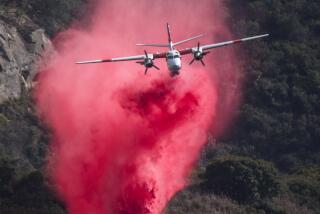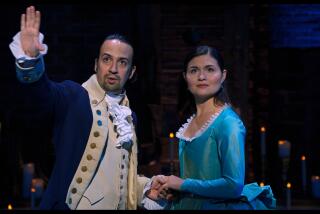Short-Haul Cargo Service : Pilot Finds His Niche in the Sky
- Share via
Even for the casual observer, there is no mistaking Steve Franklin’s plane.
The wing sits atop the fuselage with big struts for support. The landing gear dangles below. And it is one of the largest single-engine planes ever built.
The plane looks something like an oversized version of Charles Lindbergh’s Spirit of St. Louis as it drones over downtown Long Beach weekday mornings while climbing to its cruising altitude of 3,000 feet.
Franklin is a kind of airborne, short-haul truck driver. As co-owner of Aeronautical Services, he flies freight from Long Beach Airport to Santa Catalina Island in his single-engine monster two or three times a day.
The 30-year-old plane is a DeHavilland Otter, a rugged Canadian-built airborne workhorse designed for easy maintenance and the short runways commonly found on islands. Franklin can cram more than a ton of island-bound packages into the fuselage for the 15-minute flight each way.
Slow Cruising Speed
As planes go, the Otter’s 120 m.p.h. cruising speed is so slow that Franklin slides the side windows open to cool the cockpit on hot days.
Piloting the plane is “a real comfortable feeling,” he said. “I just really enjoy flying” it.
Franklin, 41, grew up around flying. He said his father, a former Navy fighter pilot, started his own airline after World War II to connect mainland Washington with the San Juan Islands. Sold by the family 10 years ago, San Juan Airlines remains the oldest commuter air carrier in the nation, he said.
Franklin was an Army helicopter pilot in Vietnam. After returning to the United States, he eventually started hauling cargo for an old pilot friend who started Aeronautical Services 17 years ago. The airline has the United Parcel Service contract to fly packages to the San Juan Islands.
UPS executives were so pleased with the little outfit’s work that they invited the firm to make deliveries to Catalina, Franklin said. The Otter is used almost exclusively for UPS deliveries, flying six days a week.
Delivers Mail
Franklin works with John Wells, who pilots an old twin-engine Beech 18 and Grumman Goose seaplane that are operated by an Aeronautical Services subsidiary, Catalina Flying Boats, to deliver daily newspapers and mail. Franklin said the mail can only be carried on the Beech or Grumman because of a requirement that it be hauled on an airplane with two engines.
The outfit sometimes makes special runs. For example, one of the pilots recently hauled electronic equipment to the island for a television show. In the summer, they haul fresh fish and other supplies for merchants catering to the tourist trade.
The day starts early. The bearded Franklin, wearing blue jeans and a blue crew shirt, arrives about 6:30 a.m. to prepare the airplane for flight and to load cargo.
An hour later, a bulky UPS truck backs up to the fuselage doors of the Otter. Franklin and his crew wrestle the heavy parcels into every available inch of space in the cabin.
Awaits Instructions
After turning the propeller by hand a few times to listen for any noises that might spell trouble, Franklin straps himself in the seat and starts the 600-horsepower engine. He taxis out to the runway and awaits the tower’s instructions. When the airport has been busy, Franklin said he has had to wait up to 40 minutes for permission to take off.
Clear days are best. “I like to take off from Long Beach and look over and see Catalina. That’s a good day for us,” he said.
But this time of year, the airport is regularly wrapped in early-morning low clouds and haze.
Facing a thicket of fog, Franklin keeps a careful watch on his instruments as the baby-blue plane roars off the runway. Gently climbing and turning, the plane breaks into a bright blue sky. Ahead lies Catalina, which on this day seems to consist of a couple of mountaintops swimming in a sea of luminescent clouds.
Below, the ocean was covered by the clouds. Franklin said his cruising altitude of 3,000 feet is high enough to give him plenty of time to radio for help if he should experience engine failure or another serious malfunction.
Sees Marine Life
But he said he flies low enough that he can see all sorts of marine life--schools of tuna, migrating whales, porpoises, an occasional sea turtle.
The mountains of Catalina--the only land visible ahead--roll ever closer. On one of the mountains sits the short strip of pavement that marks Catalina’s Airport in the Sky. The facility is nestled in the island’s barren interior, where the rugged hills are covered with scrubby brush in stark contrast to the forest of houses and buildings in Long Beach.
“It’s a heck of a nice airport,” Franklin said as the air controller welcomed him over the radio on a first-name basis.
Franklin lands and taxis the Otter to an unloading area where delivery trucks await. If the crew is shorthanded, he said, he sometimes has to make deliveries to Avalon or Two Harbors himself.
He’s a Big Wheel
On this day, however, Franklin has a few minutes to head to the old Spanish-style terminal, a white concrete building with inlaid decorative tiles, for a quick cup of coffee and a chat with Bill Cromshaw, assistant airport manager.
Franklin is “a big wheel in this little airport,” Cromshaw said.
But business is business and as soon as the unloading is done, Franklin hops back in the cockpit and is airborne a couple minutes later. On the flight back, Franklin carefully lines up the plane’s navigational aids and drops into the low clouds again for his approach into Long Beach Airport.
He ends up right on the mark. He makes it look easy, but gives some of the credit to his airplane.
“There’s hardly a pilot who is a real pilot who wouldn’t want to fly this thing,” he said.
More to Read
Sign up for The Wild
We’ll help you find the best places to hike, bike and run, as well as the perfect silent spots for meditation and yoga.
You may occasionally receive promotional content from the Los Angeles Times.






